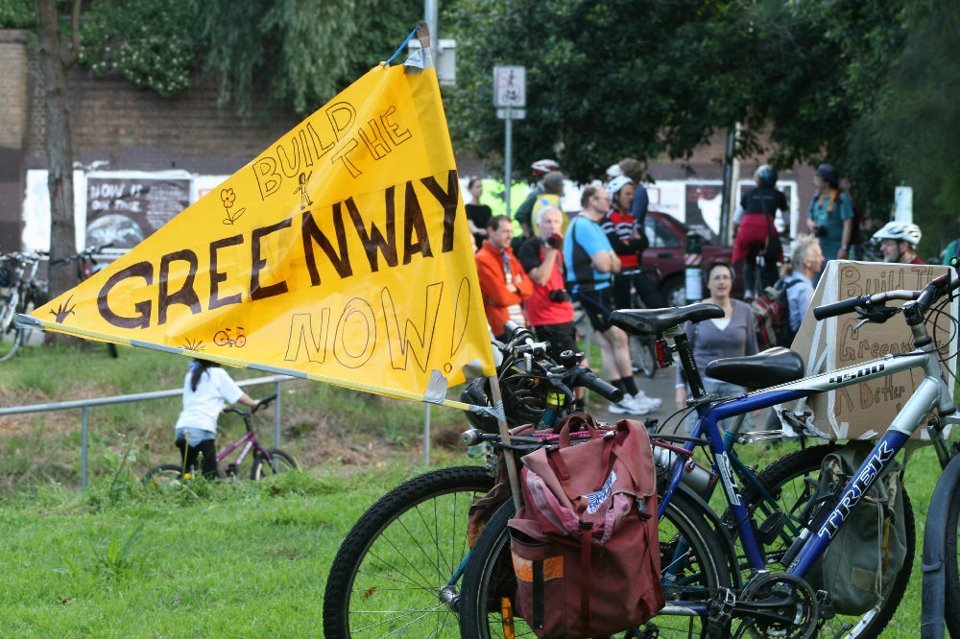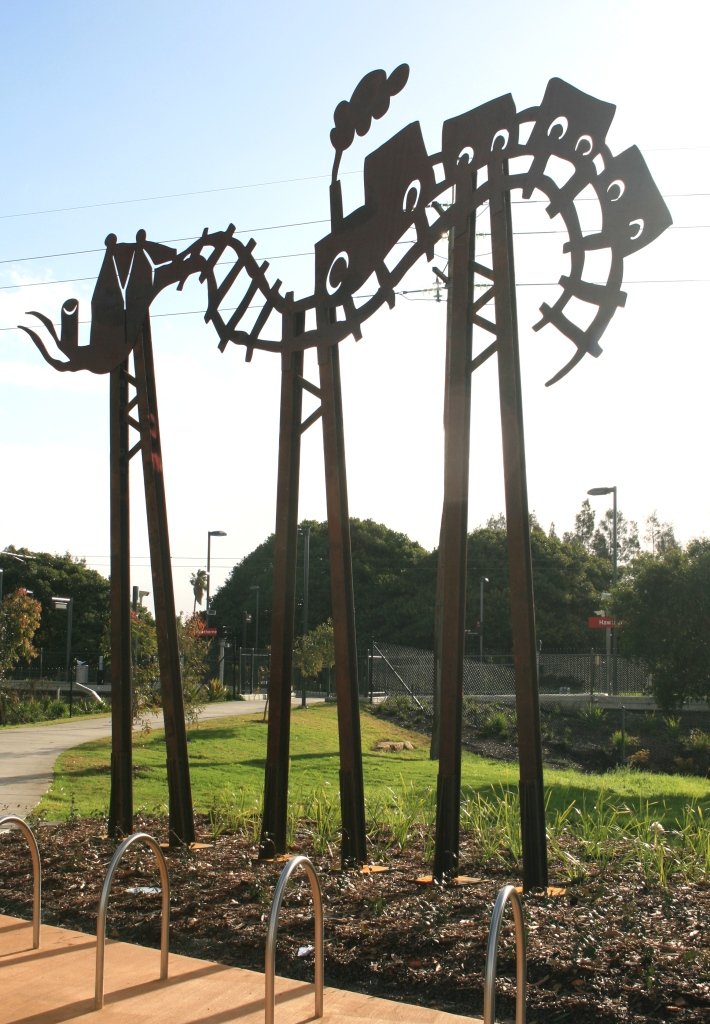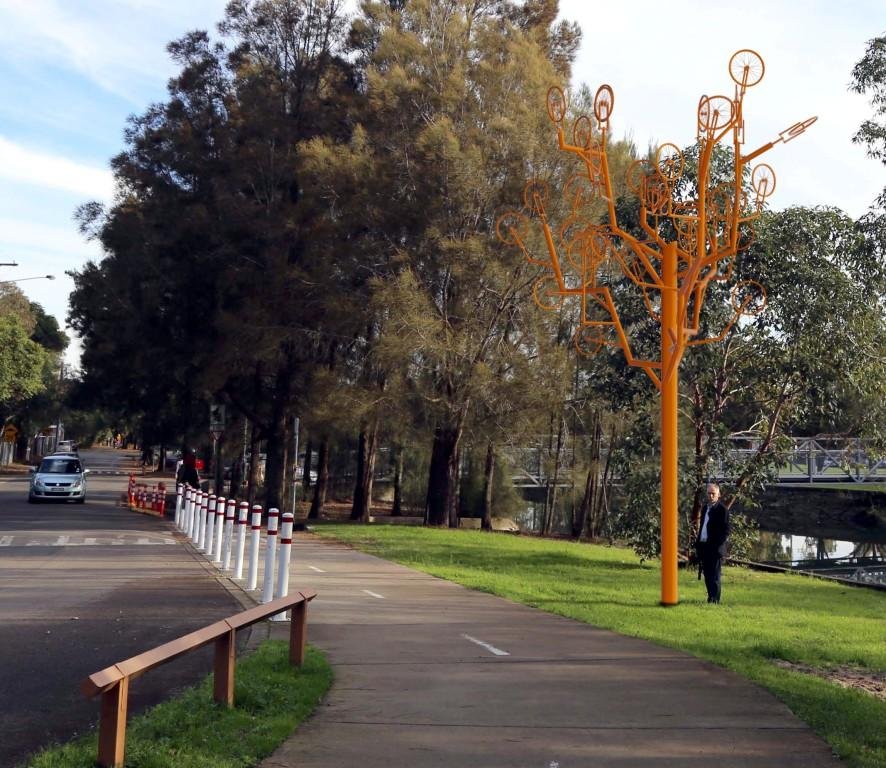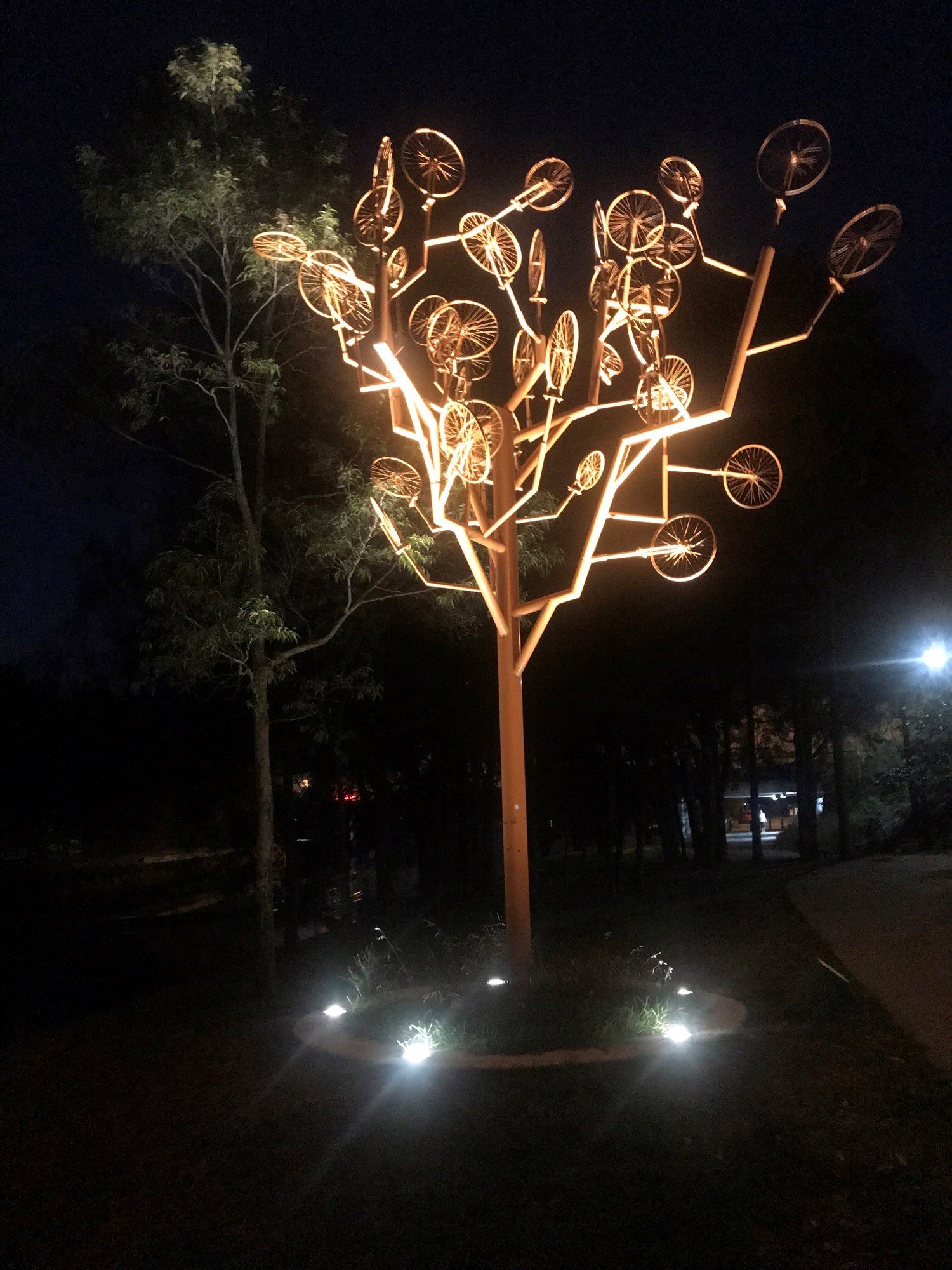The GreenWay - Sydney’s urban green corridor
The GreenWay is a 5 km green space down the guts of inner west Sydney, from Iron Cove to Cooks River.
Meet the guerilla gardener who planted trees 50 years ago.
How did the community come up with the GreenWay?
How did the community fight to save it, with the help of a special hat?
And, is it finished already?
Show Notes
Welcome
By Deborah Lennis, D’harawal woman, local Elder, and cultural advisor at Inner West Council.
What is the GreenWay?
The GreenWay – a 5.8km long green space that runs right down the ‘guts’ of inner west Sydney.
It’s an urban green corridor – “planned or unplanned linear landscape elements that allow multiple ecological, social, cultural and other uses compatible with sustainable land use”, according to Jack Ahern, one of the pioneers of the international green corridor movement.
It runs through a densely populated inner city area, with than more than 48,000 people living within the GreenWay corridor catchment.
Examples of other urban green corridors include The Highline in New York, Cheonggyecheon in Seoul, South Korea, Cuernavaca Railway Linear Park in Mexico City, Mexico and Madrid Rio in Madrid, Spain.
Clare Felton pointing to the first tree she planted in Summer Hill in 1974.
The first tree [2:40]
Clare Felton started planting trees in land off Grosvenor Crescent, Summer Hill, which is now Cadigal Reserve, in 1974. Other volunteers joined her, and the local Ashfield Council helped with supplies.
In 1978, Ashfield Council supplied 20 kgs of native grass seeds and 20 trees including 6 red ironbarks, 2 Sydney red gums and 4 casuarina trees for planting at Cadigal Reserve (GreenWay Flora and Fauna Literature Review 2010: 24). Clare also grew seedlings at home (Hawthorne Canal: the history of Long Cove Creek by Mark Sabolch 2006).
In later years, the local Venturers and the Ashfield Chinese community joined in annual Tree Planting Days.
Jo Blackman, Inner West Environment Group member, says that Clare “was one of the first people to plant down here and to see the potential for the site and to have the vision of it, the bike path, linking Summer Hill and Parramatta Road.”
‘Guerilla gardening’ [3:25]
The first record of urban guerrilla gardening was in 1973 in New York. A group called the Green Guerillas transformed a derelict private lot into a garden.
‘Obvious criminal presence’ in Cadigal Reserve, Summer Hill [4:58]
In 1989, the police were contacted, not for the first time, about the ‘obvious criminal presence’ in the area where Clare and volunteers were planting, at Cadigal Reserve in Summer Hill. ‘Incidents’ included ‘a medium sized business safe’ being dropped over the fence, shooting at train drivers and ‘yet more arson’. (Cadigal Reserve Notes)
Bushcarers and Cyclists [6:43]
Nick Chapman says that around 1998-99, two groups each had a vision for the area around the Hawthorne Canal. He says that “one group was all about cycling and thought that the corridor is a fantastic missing link in Sydney’s inner regional cycle network.” And the other group – Inner West Environment Group – was really interested in the concept of the Greenway as an urban Bush corridor.
Deborah Lennis, Cultural advisor at Inner West Council, says that the area is significant as it’s along a canal. Water was very important to our mob, the Aboriginal community. There’s midden sites along here. There’s places of rest.”
Gadigal Wangal Wayfinding project [8:55]
A series of five public artworks that interpret Aboriginal history and culture, in each Inner West Council ward. One of these artworks is along the GreenWay, Gadi the Clansman.
Gadi the Clansman by Blak Douglas [9:01]
2022 Archibald prize winner Blak Douglas has an artwork on the GreenWay, titled Gadi the Clansman.
In a video made by Inner West Council, Blak Douglas says that from the outset, “it was always important to make a dedicated acknowledgement to the main totem of the Gadigal people, the grass tree. It is the first dedicated memorial in sculptural form to the Gadigal.”
Blak Douglas says the artwork’s location, on the GreenWay near Hawthorne Light Rail station, seemed “the most appropriate place to make an inner west acknowledgement, given the history of the Wangal being Ashfield particularly, and this [the GreenWay) being a bit of a border for those two nations.”
Gadi the Clansman is part of the Gadigal Wangal Wayfinding project, where art interprets Aboriginal history and culture.
Mangroves and saltmarsh [10:10]
The GreenWay follows Hawthorne Canal, which became known as Long Cove Creek in colonial times.
Botanist and author Doug Benson says that before colonisation, the GreenWay would have been an area of mangroves and saltmarsh, blending into Casuarinas, that still grow at Hawthorne Canal Reserve. The mangroves and saltmarsh would have followed Long Cove Creek up to where the railway crosses at Parramatta Road.
Doug Benson notices that on the banks of Hawthorne Canal today, there are little plants of saltmarsh growing, “just waiting for a creative bit of environmental redevelopment here to improve the banks of Long Cove Creek.”
Missing Jigsaw Pieces: the Bushplants of the Cooks River by Doug Benson, Danie Ondinea and Virginia Bear [11:50]
A book about the plants, landscapes, history and people of the natural landscape of the Cooks River Valley. Download it for free from the Cooks River Alliance website.
Kent, Milton. Long Cove, 1920 in the Collection of the State Library of New South Wales.
Polluted and smelly [10:50]
By the 1930s, author Mark Sabolch says that Long Cove Creek was ‘stagnant, smelly and polluted.’
The solution was to turn the creek into a drain, “a straight line engineering construction to drain the new suburbs of Haberfield that were developed in the early 20th century,” as Doug Benson puts it.
Construction of Hawthorne Canal at Haberfield c1926-1929. (Supplied to the ABC by Sydney Water / Water NSW Historical Research Archive)
Research and grants
The late nineties was about research. The cyclists looked at how to make this public land a cycle link. The bushcarers investigated restoring it as a wildlife and nature corridor.
Friends of the GreenWay and community support
This community group was formed in 2007 and has been instrumental in the GreenWay progress and completion. In 2009, it had around 400 members.
Jennifer Kent says that members of the community advocated for the GreenWay by:
Signing petitions and writing letters to Members of State Parliament, Councillors and council officials
Helping out at stalls at local fairs, markets and school festivals
Attending rallies and the NSW Parliamentary Debate
Designing and distributing leaflets explaining the GreenWay vision
Making large signs and displaying them prominently on bridges in the Sydney metropolitan area
The construction of a large scale map by Bruce Ashley was a useful explanatory tool at stalls
The crafting of bandicoot hats by Claire Sives
Writing press releases for both local and Sydney newspapers by Mark Skelsey
Cooperating with other stakeholder groups in relation to the petition and stalls
Addressing council meetings, and involvement in the GreenWay Steering Committee and the current GreenWay Community Forum
Bruce Ashley
Bruce Ashley is an environmental specialist, bushcare volunteer and active transport advocate who lives right near the Greenway. He established the Cooks River to Iron Cove GreenWay concept in the early 2000s, and proposed to community groups, the four Councils and the wider community that the community work together to embark on a multi-facetted corridor vision connecting the Cooks River with Iron Cove. Bruce established and co-ordinated the Greenway Steering Committee from 2003 to 2007, was co-founder of Friends of the Greenway, and developed the first publicly exhibited Masterplan and Co-ordination Strategy for the Greenway. He is still actively involved in the corridor as a member of the Greenway Forum.
A ‘contested open space’ [11:55]
“When you’ve got a multi-purpose corridor like the Greenway, you’re bound to encounter conflict,” says Nick Chapman, “because in many respects it’s contested, open space. Because land is so expensive in the inner west, you have to think very carefully about how you then divvy up that open space to satisfy the needs of the community, which are quite diverse.”
Getting Councils on board [14:26]
Nick Chapman says that the community aimed to get the local councils on board first. At the time in 2000, the proposed GreenWay crossed four local government boundaries – Ashfiexld Council, Marrickville Council, Leichhardt Council and Canterbury Council.
Policies to get more people be active
In 1975, the Australian government launched Life Be In It, one of Australia’s most recognisable health promotion campaigns. The National Museum of Australia says “the campaign aimed to increase physical activity and general well being among Australians, and encourage them to take control of their health.”
Unanimous vote [15:16]
In August 2001, all four local councils, and the bicycle and bushcare groups voted unanimously to support the GreenWay as a concept, at a presentation at Summer Hill Community Centre.
What is bushcare? [16:00]
Bushcare volunteer Jo Blackman describes bush care as “planting natives and getting rid of weeds, and creating habitat. As well as trying to bring back the original ecology.” Inner West Environment Group lists the principles of bushcare on their website.
Rediscovery of the long-nosed bandicoot in the inner west [16:30]
According to an article in Stop Press on archived pages of the GreenWay.org.au website, “Inner West Environment Group (IWEG) volunteer Bruce Ashley was weeding in one of the revegetation sites in mid February and found a partially decomposed body of a Long Nosed Bandicoot (Perameles nasuta) lying on the ground. The site was a bushcare area fenced off from the tracks, adjacent to Johnson Park Dulwich Hill, where native bush is currently being established…. It is thought that the bandicoot was killed by a fox, which have been observed in the area by residents. According to records viewed by Tanya Leary, long nosed bandicoots were last observed as populations in the inner West in the 1950s.”
GreenWay Master Plan and funding [16:40]
In 2008 the four GreenWay Councils successfully applied for a $1.83M NSW Environmental Trust grant through the NSW Environmental Trust Urban Sustainability (Major Projects Program) for the Cooks River to Iron Cove GreenWay. The grant ran for three years, and involved the four Councils, NGOs, State Agencies and key community groups such as Friends of the GreenWay in a collaborative capacity.
Schools program [17:10]
The GreenWay Primary Schools Sustainability program used the GreenWay as an outdoor classroom to introduce kids to sustainability issues, local history and the urban environment.
Nick Chapman, an environmental scientist who developed and ran the program, says they “talked about everything” – from the bugs that live in leaf matter, stormwater, planes, the water cycle, transport and dog poo (because it’s the inner west!), and that over 1600 students participated in the all-day walks.The program was accredited by the NSW Teachers Federation and was adopted by the Observatory Hill Environmental Education Centre as ‘best practice’.
Brainstorming an arts and culture program with a bike ride
Nick Chapman had also been thinking about the need to broaden the appeal of the GreenWay beyond bushcare and cycling, which would only ever appeal to a minority in the Inner West community.
“By establishing both a community arts and culture program and the GreenWay schools education program, we would appeal to a much broader cross-section of the local community which would then help us garner more community and political support for the GreenWay vision. I think our instincts were right, as the arts and culture program is now in its 12th year and it gets bigger and better every year, ” said Nick.
In true GreenWay style, it was kicked it off with two bike rides along the GreenWay in mid/late 2009 involving a small group of local people who were enthusiastic about establishing a GreenWay arts and culture program. Suzy Carter (long-standing GreenWay champion, member of the GreenWay Forum and owner of Hero Frock, suppliers of costumes to the film industry at Canal Road Film Studios) and Nick Chapman wrote up ideas on how the corridor could become a hub for community arts and culture.
Public art in the inner west light rail
Another important dimension to the GreenWay Arts and Culture Program is the public art program.
Former GreenWay Place Manager Nick Chapman persuaded Transport NSW to use public art in the design and construction of the Inner West Light Rail Stops, which opened in 2014.
Project managed by Inner West- based veteran cultural planner and public art strategist Marla Guppy, each of the nine light rail stops has a public art work within it, many of which were commissioned from local artists and/or inspired by the GreenWay community.
Public art on the GreenWay
One of the most notable ones is ‘tree cycle’ by Inner West artist Graham Chalcroft, located at the northern end of the GreenWay next to the City West bridge over the Canal, which was funded by the GreenWay Sustainability Project in 2017. Nick Chapman sourced all the bike wheels from local Inner West bike shops who were happy to give them away.
475 000 mosaic pieces - the award winning Hawthorne Canal Tunnel
The Hawthorne Canal Tunnel is another community achievement, taking six years to complete. It has a 22 panel mosaic mural featuring the aquatic environment of the Canal. Six local primary schools designed it, and an amazing group of community volunteers made it under the direction of local mosaic artist Noula Diamantopolous.
Every single one of the 475,000 mosaic pieces was put in place by a volunteer.
Street art
Street art has always been an important dimension to the GreenWay and there’s many examples of street art – from the inspiring to the annoying – at various locations along the GreenWay. It’s a constantly evolving tapestry and socio-cultural backdrop to the corridor.
GreenWay Art Prize and exhibition
The arts and culture program started with the GreenWay Art Prize and exhibition in 2010 and still runs today.
Nick Chapman describes how the exhibition began and evolved:
“One Sunday afternoon in January 2010 I walked into the Art Est Gallery and Art School Leichhardt to introduce myself and the GreenWay to the Director Jennifer McNamara. I rather naively suggested that she might be interested in hosting the inaugural community GreenWay Art Exhibition, which she was happy to do, having only opened her doors 12 months prior. We had a little start-up money from the GreenWay Sustainability Program and Leichhardt Council to get it going.
In later years we secured funding from the other three councils, Cooks River Alliance and Petersham Bowlo.
Art Est hosted the exhibition until 2020, when the lease expired and Jen had to pack up and move to her new space on the Annadale/Leichhardt border. In 2021 it was in the Mungo Scott Flour Mill Space at Lewisham West and it was our biggest event yet, attracting over 300 art works – I think we exhibited about 70 works."
The GreenWay Art Prize draws hundreds of prestigious and emerging local artists across a wide range of art forms including painting, drawing, sculpture, photography and mixed media.
Today the arts and culture program includes public art and GreenWay Edge arts camp.
‘Creepy canal’ no more [18:40]
By 2010, a lot has changed and a lot has been achieved. There’s kids. There’s art. There’s bikes. There’s tours of art on bikes! It’s not the creepy canal anymore. People know the GreenWay.
But it’s not finished. The GreenWay vision is a continuous bush and active transport corridor – from Iron Cove to Cooks River. But at the southern end, where Clare Felton first planted trees in the 1970s, there’s massive roads in the way, like Paramatta Road.
The GreenWay will be finished [19:47]
In 2010, the state Labor government announces something that the community and groups like Friends of the GreenWay had been lobbying for – that the old Rozelle goods line would be converted into the light rail, and that they would build the missing part of the shared path from Paramatta Road down to Cook’s River as part of the light rail works. The GreenWay would be finished.
The brakes go on [20:08]
In September 2011, former NSW Premier, and then Transport Minister, Gladys Berejiklian puts the brakes on the GreenWay. She promises to replace it with a more ”integrated” plan to promote walking and cycling. “Which is political speak for, it’s canned,” says Nick Chapman. The light rail is set to go ahead without the GreenWay paths.
Community protests [20:54]
Friends of the GreenWay member Jennifer Kent says the community was distraught and heartbroken.
But, they organised quickly with ‘Save the GreenWay’ cycle rallies and Days of Action.They held at least five Days of Action with bike rides and speeches of support by politicians from all parties – Greens, Labour and the Liberals, with hundreds of people coming.
Speakers at the protests included Friends of the GreenWay’s Bruce Ashley and Jud Agius, former Ashfield Councillor Alex Lofts, and former Marrickville Mayor Fiona Byrne, former deputy Marrickville Mayor Sam Iskandar, former Leichhardt Mayor Rochelle Porteous, State Member for Balmain Jamie Parker, State Member for Strathfield Charles Casuscuelli, Federal Member for Barton Linda Burney, and Bicycle NSW CEO Omar Khalifa.
Inner West Icons host Bernie Hobbs even MCed one of the rallies at Johnston Park in Dulwich Hill.
The big petition
In New South Wales, if you get a petition with 10 000 signatures, you can get an issue debated in State Parliament. The campaign focused on gathering the signatures required so the future of the GreenWay could be debated by the state members of parliament.
Every market, every school fair [22:45]
Friends of the GreenWay volunteers held stalls at school fairs, local festivals, and markets, including Summer Hill Fair, Orange Grove Markets and Leichhardt Fiesta. Jennifer says Jud Agius would jump on the microphone and talk about the campaign, while she and other volunteers would approach people lining up for coffee or food.
A special hat [22:25]
Jennifer describes the ‘visual gimmick’ they used to wear – “a black cap with beautiful tawny tanny um, stuffed long pointed nose with little black eyes and beautiful, soft ears at either side.” Made by Claire Sives, Jennifer says it brought attention to what they were doing, and encouraged people to look for the long-nosed bandicoot.
If you went to market, school fete, or festival in the Inner West in 2012, chances are you met GreenWay volunteers or spotted those long-nosed bandicoot hats.
Petition debated… and lost [23:00]
The petition got its 10 000 valid signatures and the GreenWay was in the New South Wales State Parliament on the 1st of August, 2012. The Transport Minister, Gladys Berejikilian said they were still deferring the GreenWay.
Councils take on a Place Management Model
Nick Chapman says “So the local councils who by then had really actually invested quite a lot in this Greenway thought, Well, what are we going to do? How can we keep it going?” He says that a Macquarie University report recommended they adopt a Place Management model, which is a “multidisciplinary approach to the planning, design and management of public spaces.” Nick Chapman was employed as the GreenWay Place Manager.
Things look up [23:32]
Nick Chapman says that one of the “shining points of the Greenway story was when we walked in to the State Government of New South Wales’ Minister for Transport’s office and we had four local members.” The members were from Australia’s three major parties, Labour, Liberal and Greens, again reflecting the ongoing, bipartisan support for the GreenWay at a local government level.
In 2016, the state government committed to finishing the GreenWay [23:48]
Note: the error in the podcast saying 2018 will be corrected. Apologies for this error.
The state government and the newly created Inner West Council each committed $7 million each to completing the GreenWay’s missing links. In 2018 Inner West Council adopted the Master Plan.
A slow finish line [23:48]
Delays and covid have meant the GreenWay is not finished. The NSW state government and Inner West Council have committed to its completion. Inner West Council lists GreenWay construction updates.
Public health benefits [24:13]
Susan Thompson is a Professor of Planning at the University of NSW, and works at the interface of public health and urban planning. She brings her university students along the GreenWay frequently, to show them what an exemplar it is of biodiversity and environmental sustainability. She says it encourages social connection and recreation, and its most obvious public health benefit is that it enables people to be physically active.
As we know, being physically active is really important for fighting a lot of the chronic diseases that are everywhere in our society, things like diabetes, heart disease, and importantly depression.
Susan points out that the GreenWay makes a bigger contribution too. “The Greenway has lots and lots of opportunities for the health of individuals, but it’s also important for the planet’s health.”
Stay updated with the GreenWay Community Forum
The GreenWay Community Forum gives support and advice for the vision of the GreenWay as an ecological, biodiversity, cultural, recreational and active transport corridor. It advocates on GreenWay matters, supports liaison and communication between Council and the community, and identifies and implements opportunities for community programs and partnerships.
See Forum meeting dates and minutes, Terms of Reference and membership on their page on the Inner West Council website.
GreenWay Campaign credits
Jennifer Kent states that apart from the people already mentioned above and in the podcast, the following people should be recognised for their long term efforts.
Apologies for any unintentional omissions.
Liz Locksley, Colin Jones, Jud Agius, Jo Hobson, Peter Olive, Fiona Campbell, Greg Stonehouse and Bob Moore.









